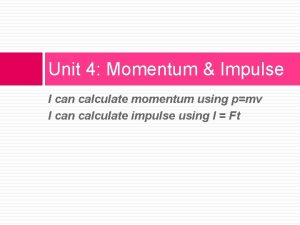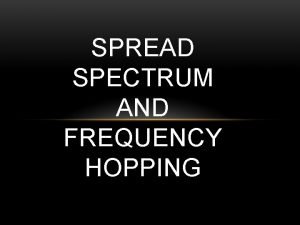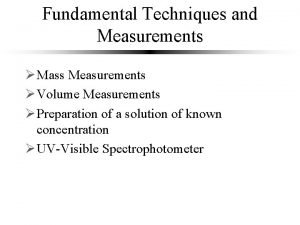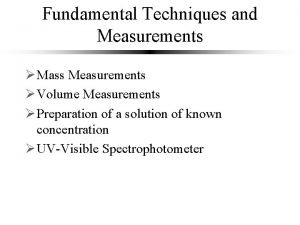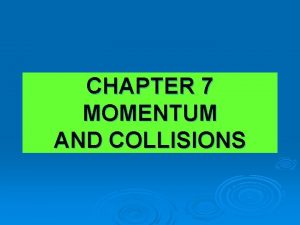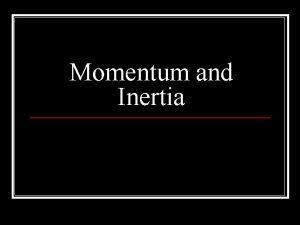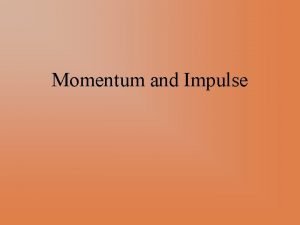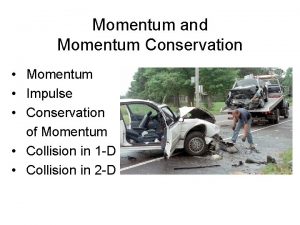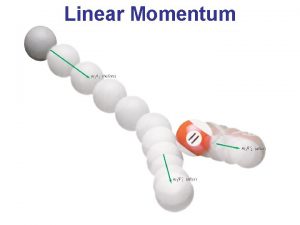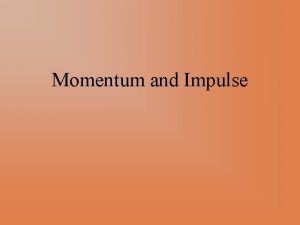Momentum and Momentum Spread Measurements Momentum Measurement For















- Slides: 15

Momentum and Momentum Spread Measurements

Momentum Measurement For Dipole 1 (in Me. V/c) = 0. 108 + 2. 971 I (in Amps) as implemented in the magnet table • New addition to procedure – measure charge on BPM-02 and BPM-03 to make sure all beam is measured • Is BPM-03 a better measure of 45 than YAG-04? • Need shot-by-shot measurement of beam centroid on YAG-04 to use!

Momentum v. Phase New data shows no change from ‘run 3’ and ASTRA simulations (parameters not identical)

Momentum v. Power • New data shows same behaviour as previous experiments • Fit parameter indicates effective shunt impedance of 23. 3 M /m • Missing momentum is still missing!

Momentum Spread Measurement Beam size given by If x is minimised using QUADS 1 - 4 Can calculate momentum spread from dispersion D and the beam size at YAG-04

Dispersion • Calculate – QUADS 5 -6 must be off – may be a problem if beam image is large – Does not account for any residual fields • Calculated = 20600 pixels • Measured = 16400 pixels • Measure – Take data for three or more magnet settings/image positions on the screen • Measure on-the-fly – Measure dispersion for each data point

Measurement on-the-fly • Bottom 5 points taken at low charge – not representative! • Even there is considerable statistical variation on dispersion for nominally identical measurements • Using an average value for dispersion produces smoother parameter response (all data re-analysed this way) • Measuring dispersion up-front and using a single value may lead to a small systematic error but removes large random error allowing trends to be seen more easily

Data extraction • Summation – Doesn’t assume particular line shape – Quick – no fitting! – Susceptible to problems with background • Gaussian Fitting – Seems to get width of signal even for non-Gaussian profiles – Still has issues with background at low charge • By-eye (pencil and paper) – Allows intelligent background subtraction – Cannot be used for large data sets

Momentum Spread v. Solenoid Previous data showed higher momentum spread at optimum solenoid settings for transverse properties Not confirmed by first re-measurement • Single shot data! Subsequent data • Low charge data not good • Some hint in higher charge data • More detailed scans required • ASTRA simulations would also be good

Momentum Spread v. Phase Previous data looked convincing • Minimum momentum spread not identical to simulation but parameters differ x not minimised Single shot data, phase for x not minimised minimum momentum spread depends on analysis technique! Data collected so far does not allow the phase for minimum momentum spread to be accurately assessed!

Momentum Spread v. Phase (TDC) • Two data sets, one with the beam set up for TDC work ( y minimised? ) and one with both x and y ‘minimised’ and TDC actually on. • x minimisation not good enough on either set to be useful • Getting slice momentum spread measurements could be extremely challenging!

Momentum Spread v. Charge • Previous work – Low charge data limited by clipping • New data – Low charge data influenced by background subtraction issues Clipping in the magnet vessel

Charge Dependence Along the Beamline BA 2 – Measure on YAG-09, careful setting of QUAD-12 required BA 1 – Measure on BA 1 -YAG-02, beam transport could be an issue, no QUADs after dipole so no control of dispersion

Charge Dependence Along the Beamline Some interpolation and limited extrapolation • Is behaviour as expected? • Charge transport to BA 1 an issue? – ICT in BA 1 – BPMs for charge measurement • AP shifts for characterising beam in BA 1?

Summary Momentum measurements • New data confirms previous results – momentum still missing! Momentum spread measurements • Lots of data but much of it useless - need to improve procedures! – minimisation – Eliminating background issues (turning lights off, subtracting dark images, optimising data extraction) – Shot-to shot YAG image analysis, automated data collection routines? • Important beam parameters not accurately measured – Phase for minimum energy spread – Evolution of charge dependence along the beamline • Simulations with matching parameters to data would help!
 Unit for momentum
Unit for momentum Formuö
Formuö Typiska novell drag
Typiska novell drag Tack för att ni lyssnade bild
Tack för att ni lyssnade bild Ekologiskt fotavtryck
Ekologiskt fotavtryck Shingelfrisyren
Shingelfrisyren En lathund för arbete med kontinuitetshantering
En lathund för arbete med kontinuitetshantering Underlag för särskild löneskatt på pensionskostnader
Underlag för särskild löneskatt på pensionskostnader Tidbok för yrkesförare
Tidbok för yrkesförare Anatomi organ reproduksi
Anatomi organ reproduksi Förklara densitet för barn
Förklara densitet för barn Datorkunskap för nybörjare
Datorkunskap för nybörjare Stig kerman
Stig kerman Hur skriver man en debattartikel
Hur skriver man en debattartikel Delegerande ledarskap
Delegerande ledarskap Nyckelkompetenser för livslångt lärande
Nyckelkompetenser för livslångt lärande
